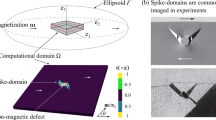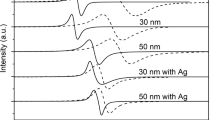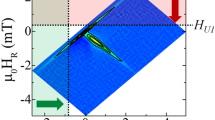Abstract
In the generally accepted theory of the ordinary magnetization curves of ferromagnetics, due to Becker, Kersten and many others, and fully described by Becker and Doring1., coercivity is related to the amplitude of internal stress variations through their effect on domain boundary movement. Although there can be little doubt as to the correctness of the basic ideas, or to their wide applicability, the treatment cannot account for coercivities of 500 oersted, and more, which are obtained in modern permanent magnet materials, without arbitrary and improbable assumptions about the magnitude and character of the internal stress variations. It occurred to one of us some years ago that for those alloys of the dispersion-hardening type for which the higher coercivities are found, an entirely different type of explanation might be possible, and some preliminary calculations gave promising results. This line of inquiry was interrupted by the War, and no more than vague references to it have been published2, though it has been discussed verbally and in correspondence with others interested. A systematic attack on the problem was resumed at the beginning of 1946, and a full account of the work has now been prepared. In view of the inevitable delays in publication a brief account may be appropriate here. It may be stated quite frankly that the immediate stimulus to this communication has been two short and admirable papers by Néel3, which have just appeared, and which show that he has been thinking along similar lines with particular reference to powder magnets.
This is a preview of subscription content, access via your institution
Access options
Subscribe to this journal
Receive 51 print issues and online access
$199.00 per year
only $3.90 per issue
Buy this article
- Purchase on Springer Link
- Instant access to full article PDF
Prices may be subject to local taxes which are calculated during checkout
Similar content being viewed by others
References
Becker, R., and Döring, W., "Ferromagnetismus" (Springer, Berlin, 1939). (Photo-lithoprint reproduction, Edwards Bros., Ann Arbor, Michigan, 1943.) See also Zersten, M., Phys. Z., 44, 63 (1943).
Stoner, E. C., Proc. Phys. Soc., 52, 175 (1940); J. Inst. Elec. Eng., 91, 340 (1944); Phil. Mag., 36, 803 (1945).
Néel, L., C.R. Acad. Sci. Paris, 224, 1488 and 1550 (1947).
For a review, see Constant F. W., Rev. Mod. Phys., 17, 81 (1945).
For a review, see Hoselitz, K., J. Sci. Instr., 23, 65 (1946).
Author information
Authors and Affiliations
Rights and permissions
About this article
Cite this article
STONER, E., WOHLFARTH, E. Interpretation of High Coercivity in Ferromagnetic Materials. Nature 160, 650–651 (1947). https://doi.org/10.1038/160650a0
Issue Date:
DOI: https://doi.org/10.1038/160650a0
This article is cited by
-
Coercivity mechanisms in nanocrystalline Sm–Co–Cu thin films: the spring effect
Applied Nanoscience (2023)
-
Surface Texture Transformation in Micro-Cutting of AA6061-T6 with the Rehbinder Effect
International Journal of Precision Engineering and Manufacturing-Green Technology (2021)
-
Magnetic and thermal analysis of MFe2O4 (M = Co, Mn, Zn) nanoparticles
Journal of Thermal Analysis and Calorimetry (2010)
-
Effect of cobalt plating on the magnetic properties of ?-Fe2O3 powders
Soviet Powder Metallurgy and Metal Ceramics (1978)
-
Magnetische Eigenschaften und elektronenmikroskopische Struktur elektrolytisch niedergeschlagener d�nner Schichten aus Nickel-Eisen-Legierungen
Zeitschrift f�r Physik (1958)
Comments
By submitting a comment you agree to abide by our Terms and Community Guidelines. If you find something abusive or that does not comply with our terms or guidelines please flag it as inappropriate.



